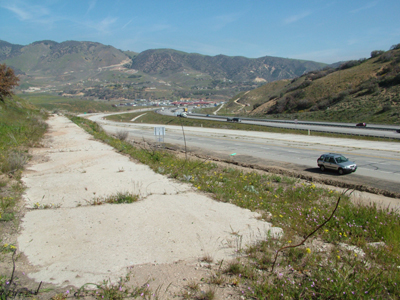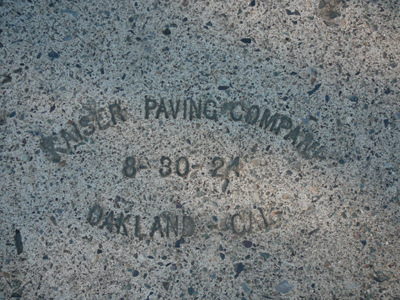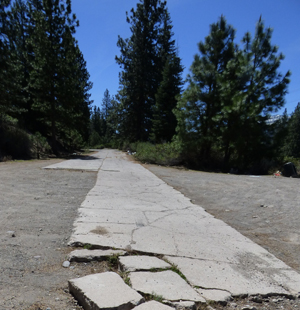
Questions?
Email us at: JandK@LivingGoldPress.com
 HOME
HOME
 |
Email us at: JandK@LivingGoldPress.com
|
Kaiser the Concrete King in California© Jill Livingston 2017 A version of this article originally appeared in Jefferson Backroads January 2017 |
 Section of extant concrete highway near Tejon Pass in Southern CA |
 A Kaiser concrete stamp in Redding, CA |
 A section of old highway, Siskiyou County, near Weed, CA |
|
Kaiser. You know the name (think “health insurance”) but you might be surprised to hear it associated with, believe it or not, old concrete highways. You might also be surprised to learn that the first state highways in northern California (some later designated as US Highways) were merely 15’ wide and 4” thick. Yes, that’s 15 feet to carry two lanes of traffic. And these highways of the 19-teens and 20s were considered marvels of engineering.Many of these winding ribbons of concrete were poured by the Henry J. Kaiser Paving Company. Amazingly, a few sections of this 100 year old road have survived, including in Siskiyou County, in Redding and Anderson, numerous sections in the Red Bluff area, and even a short piece near the Tower Bridge in West Sacramento. Some contain a concrete stamp reading “Kaiser Paving Company” and a date. The story of the paving company is a fascinating story of a self-made man. Kaiser came west from New York to seek his fortune in 1906. According to his future father-in-law, the “fortune” needed to be at least $125 a month plus a house for Henry J. to claim his bride. Ambitious, self-confident Henry was able to marry in less than a year. Employed in a hardware store in Spokane, Washington, the workaholic sold sand and gravel on the side and kept his eyes open for opportunities. When one paving contractor defaulted on a job, he started his own paving company with two employees and completed the job. Moving south to Oakland, the company built a reputation for “first class speedy work”. Their first California job was the stretch of US99 between Redding and Red Bluff. Kaiser crews were able to pave one mile of highway per week when the standard rate was a mile every two weeks. “Find a need and fill it” said Kaiser. He had his own sand and gravel plants, cement plants and heavy equipment manufacturing plants. He pioneered the switch from horse power to motor driven tractors in road construction. Before long Kaiser was ready for bigger concrete things, that is to say, dams. After working on Hoover Dam and two of the Columbia River dams, Kaiser lost out on the bid to build Shasta Dam in 1938 but ended up providing all of the 6 million barrels of concrete, shipping the cement from a limestone deposit and processing plant developed just for the occasion on Permanente Creek near San Jose. During WWII Kaiser had seven shipyards on the west coast that employed women and minorities. After the war he branched out into automobiles (750,000 built), aluminum products and building houses for post-war families. The Kaiser Permanente HMO evolved from the medical care provided for the dam builders and shipyard workers. Henry J. moved to Honolulu in 1955 and built one of the earliest resort hotels. And to think it all started with a small highway paving job a century ago… |